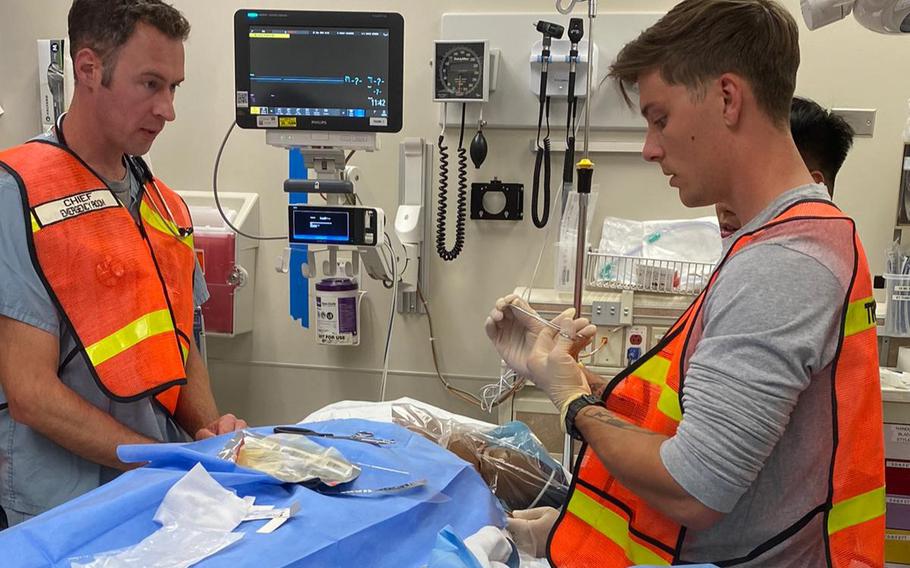
Dr. (Maj.) Josh Krieger, Emergency Department Chief, left, and Sgt. Errol Benitez, a 68W Army Combat Medic, practice critical care procedures on a medical mannequin at Evans Army Community Hospital at Fort Carson, Colo., on Sept. 19, 2024. (Victor DaSilva/U.S. Army)
(Tribune News Service) — As the war in Ukraine kills and injures tens of thousands, European countries are getting more serious about medical training and ensuring the care is standardized across NATO nations.
In a large-scale ground war in Eastern Europe, casualties could be, for example, transferred from a Danish Stryker ambulance to a Hungarian ambulance and then to a Lithuanian and Spanish joint field hospital, as they were in a recent European exercise. So it’s key the medical standards are the same as patients are transferred, said Maj. Dylan Bryant, with the 140th Medical Group, who attended a recent Fort Carson training and the European exercise.
If the war expanded into NATO countries, the volume of patients could also be much greater and seamless integration from evacuation to the hospitals, all facilities covered by the NATO standards, will be key to saving lives, said Maj. Travis Kaufman, deputy brigade surgeon with the 4th Security Force Assistance Brigade.
“In Ukraine right now, they’re evacuating soldiers by train, which is something we haven’t seen since World War II,” Kaufman said. During the wars in Iraq and Afghanistan, American and NATO troops could be evacuated within an hour by helicopter and now they could wait a day for a train.
So it’s important that the medical responses have clear and standardized communication for those needs.
Over two weeks of training, 74 students including military professionals from six countries learned how to evaluate medical facilities, including field hospitals, to meet NATO standards. As part of the training, students practiced inside Evans Army Community Hospital, going through a granular evaluation with the emergency room staff.
The student evaluators asked the hospital staff detailed questions about their equipment, supplies and staffing levels, as they practiced for evaluations of NATO hospitals.
One of the instructors, Marko Saric, from Bosnia-Herzegovina, explained numerous countries are asking for evaluation and starting the long process to meet the internationally accepted standards.
They are starting the process amid a “very, very harsh international situation,” he said.
Kaufman said medics in Ukraine are facing drone attacks as they are treating casualties, so training is focusing on speed to get medics off the battlefield faster.
It’s also important to ensure that those on the front lines have the right training to treat themselves if necessary and countries are providing sustainable training over time.
“(If) you’re shot in the arm, you should be able to take a tourniquet and put it on yourself,” Kaufman said.
As a member of a Security Force Assistance Brigade, Kaufman spends extended periods training troops in other countries building relationships, and ensuring that troops across countries have the right equipment and training to work together successfully.
The NATO medical evaluations, while challenging, give units eight weeks to make corrections so they can meet the standards, he said.
Maj. Alice Happel, a medical staff officer from the United Kingdom, found the training helpful particularly around internationally accepted medical terms that she can use later.
“We all have different words, and letters and terminology for different things, so learning other people’s language, particularly in the medical context is really useful,” she said.
Kaufman and Bryant saw the NATO international medical response come together to treat hundreds of patients during an exercise. While there are differences and tweaks necessary, Bryant said, medical treatments for common conditions like the pain, anxiety and delirium that follow a blast injury were similar, and they could form cohesive teams quickly and understand what other medical professionals were doing.
(c)2024 The Gazette (Colorado Springs, Colo.)
Visit The Gazette at www.gazette.com.
Distributed by Tribune Content Agency, LLC.